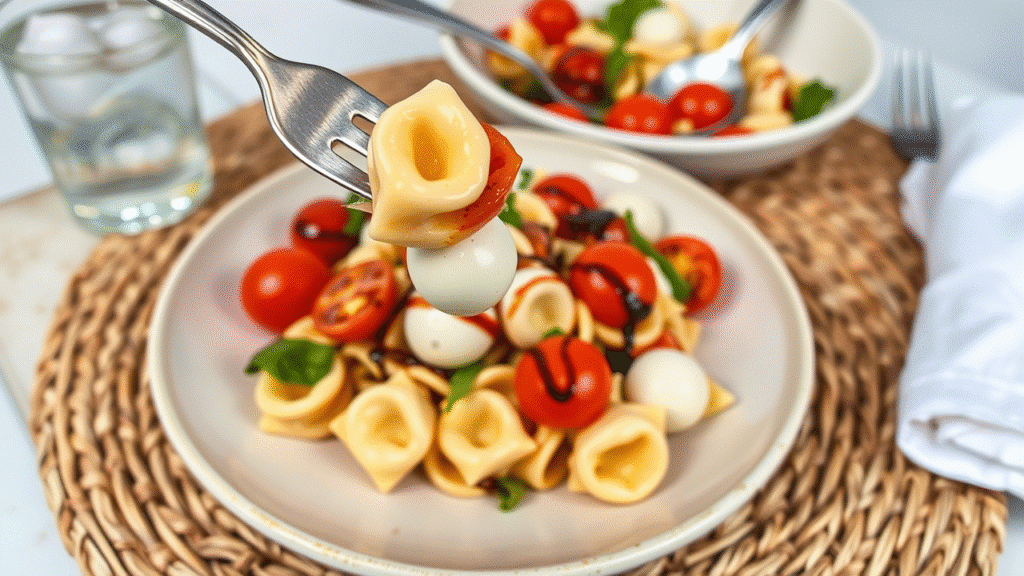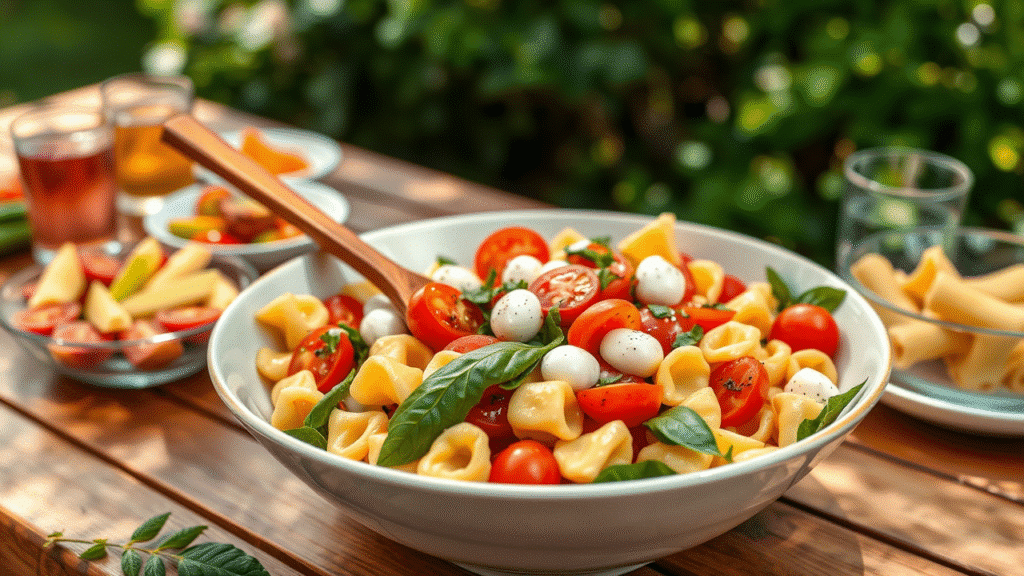There’s something almost magical about watching a simple caprese salad transform into something entirely unexpected. Last summer, while catering a wedding in Tuscany, I watched the bride’s Italian grandmother shake her head disapprovingly at my pasta salad setup. Twenty minutes later, she was asking for the recipe while sneaking a third helping when she thought no one was looking.
This isn’t your typical mayonnaise-heavy pasta salad that wilts under the Mediterranean sun. Caprese Tortellini Pasta Salad represents the brilliant marriage of Italy’s most beloved flavors with the practical needs of modern entertaining. The dish takes the classic caprese combination – fresh mozzarella, ripe tomatoes, and aromatic basil – and reimagines it as a substantial, crowd-pleasing salad that actually improves as it sits.
What makes this particular version extraordinary is the use of cheese-filled tortellini instead of plain pasta shapes. The tortellini adds richness and substance while eliminating the need for additional protein, making it a complete meal in itself. The pasta’s natural starch content, when properly managed, creates a silky coating that helps the dressing cling beautifully to every element.
The technique here borrows from traditional Italian pasta preparation but adapts it for cold service. We’re talking about controlled starch release, proper emulsification, and timing that ensures every component maintains its integrity while contributing to the overall harmony of flavors.
Ingredients & Substitutions

For the Pasta Base:
- 1.5 pounds fresh cheese tortellini (or high-quality frozen)
- 2 tablespoons kosher salt for pasta water
- 2 tablespoons extra virgin olive oil for tossing
For the Caprese Elements:
- 1.5 pounds mixed heirloom tomatoes, various sizes
- 1 pound fresh mozzarella (preferably buffalo mozzarella)
- 1 cup fresh basil leaves, roughly torn
- 1/2 small red onion, paper-thin slices
- 1/4 cup pine nuts, lightly toasted
For the Dressing:
- 1/2 cup best-quality extra virgin olive oil
- 1/4 cup aged balsamic vinegar
- 2 tablespoons fresh lemon juice
- 2 garlic cloves, microplaned
- 1 teaspoon Dijon mustard
- 1 teaspoon honey
- 1 teaspoon kosher salt
- 1/2 teaspoon freshly cracked black pepper
For Finishing:
- 1/2 cup Parmigiano-Reggiano, freshly grated
- Flaky sea salt for final seasoning
- Additional basil leaves for garnish
The tortellini choice is crucial here. Fresh tortellini from a good Italian deli or made in-house provides the best texture and flavor, but high-quality frozen varieties work excellently. Avoid dried tortellini – they become too firm and don’t integrate well with the other components. If fresh isn’t available, brands like Barilla’s refrigerated line or Costco’s Kirkland fresh tortellini are reliable choices.
For the mozzarella, buffalo mozzarella (mozzarella di bufala) offers superior creaminess and flavor complexity, but it’s more delicate and requires careful handling. Fresh cow’s milk mozzarella works beautifully and holds its shape better in the salad. Avoid low-moisture mozzarella – it lacks the creamy texture essential to authentic caprese flavor.
Tomato selection makes or breaks this dish. Use a mix of sizes and varieties for visual interest and flavor complexity. Cherry tomatoes provide sweetness and hold their shape well, while larger heirlooms contribute juice that becomes part of the dressing. In winter months, good-quality San Marzano canned tomatoes, drained and roughly chopped, work better than flavorless out-of-season fresh tomatoes.
The basil must be fresh – dried basil has no place in caprese preparations. If fresh basil isn’t available, substitute with fresh spinach leaves and a small amount of dried basil, though the flavor profile will change significantly. For those with basil allergies, fresh oregano or even fresh mint can provide aromatic complexity.
Pine nuts add textural contrast and nutty richness, but they can be expensive and some people have allergies. Toasted sunflower seeds or chopped toasted walnuts provide similar crunch and richness at a fraction of the cost.
Step-by-Step Instructions
Preparing the Pasta Foundation
Start with a large pot of water – at least 6 quarts for this amount of pasta. The volume matters because tortellini need space to move freely without sticking together. Salt the water generously until it tastes like mild seawater. This is your only chance to season the pasta itself, and under-salted pasta water results in bland tortellini that no amount of dressing can fix.
Bring the water to a rolling boil before adding the tortellini. Fresh tortellini cook quickly – usually 3-4 minutes from the time they float to the surface. Frozen tortellini need an additional 1-2 minutes. The key is achieving al dente texture that will hold up to the dressing without becoming mushy.
The Critical Cooling Process
Here’s where most pasta salads go wrong. Instead of shocking the tortellini in ice water, which can make them waterlogged, drain them thoroughly and immediately toss with the 2 tablespoons of olive oil. This prevents sticking while allowing them to cool gradually, which preserves their texture better than rapid cooling.
Spread the oiled tortellini on a large sheet pan in a single layer. This allows air circulation and prevents steaming, which would make them gummy. Let them cool to room temperature, tossing occasionally with clean hands to prevent clumping.
Preparing the Caprese Components
While the pasta cools, prepare your tomatoes with careful attention to liquid management. Cut larger tomatoes into wedges, removing the seed cavities if they’re particularly watery. Leave cherry tomatoes whole or halved depending on size. Salt the cut tomatoes lightly and let them drain in a colander for 15 minutes – this removes excess water that would dilute your dressing.
Cut the mozzarella into irregular chunks rather than perfect cubes. The irregular shapes provide more surface area for the dressing to cling to, and they look more rustic and appealing. If using buffalo mozzarella, handle it gently and add it last to prevent breaking.
Creating the Emulsified Dressing
The dressing technique separates professional results from amateur attempts. In a small bowl, whisk together the lemon juice, balsamic vinegar, and microplaned garlic. Let this mixture sit for 5 minutes to allow the garlic to mellow slightly.
Add the Dijon mustard and honey, whisking until smooth. These emulsifiers help bind the oil with the acid, creating a stable dressing that coats evenly. Slowly drizzle in the olive oil while whisking constantly – this creates a proper emulsion that won’t separate on the pasta.
Assembly and Flavor Development
In a large serving bowl, combine the cooled tortellini with the drained tomatoes. Add the dressing gradually, tossing gently with clean hands or large spoons. You want every piece of pasta coated but not swimming in dressing. The starch from the pasta will help bind everything together.
Add the mozzarella chunks and torn basil leaves, folding them in gently to prevent bruising the basil or breaking the cheese. The paper-thin red onion slices go in last – their sharp flavor needs time to mellow, but they shouldn’t overpower the other elements.
Final Seasoning and Rest Period
Taste and adjust seasoning with salt and pepper. The salad will taste under-seasoned at this point – the flavors need time to marry and develop. Cover and refrigerate for at least 2 hours, but preferably 4-6 hours. This resting period allows the pasta to absorb the dressing flavors while the tomatoes release their juices, creating a more cohesive dish.
Cooking Techniques & Science

The success of caprese tortellini salad relies on understanding starch behavior in pasta. When tortellini cook, their surface starches gelatinize and become sticky. Proper cooling technique prevents this starch from creating a gluey mess while preserving enough surface starch to help the dressing adhere effectively.
The gradual cooling method works because it allows the starch molecules to set in an organized way rather than seizing up rapidly. This is why restaurant pasta salads often have better texture than home versions – professional kitchens understand this cooling science.
Emulsification in the dressing creates stability that prevents separation. The lecithin in egg yolks (from the Dijon mustard) acts as an emulsifier, helping oil and vinegar combine into a smooth mixture. This is crucial for even distribution throughout the salad.
The resting period isn’t just about flavor melding – it’s about moisture equilibrium. The pasta continues to absorb liquid slowly, the tomatoes release their juices, and the mozzarella contributes its milky richness. This creates a self-saucing effect that makes the salad more cohesive over time.
Acid balance in the dressing serves multiple purposes beyond flavor. The acidity helps preserve the bright color of the basil and prevents the mozzarella from breaking down too quickly. It also provides a counterpoint to the rich cheese filling in the tortellini.
Serving & Pairing Suggestions
Presentation matters enormously with caprese tortellini salad. Serve it in a large, shallow bowl that showcases the colorful ingredients rather than hiding them in a deep vessel. The visual appeal is part of the experience – people eat with their eyes first, and this dish delivers stunning visual impact.
For elegant presentation, garnish with additional torn basil leaves and a drizzle of your best olive oil just before serving. A few cherry tomatoes left whole and scattered on top add color and suggest the abundance of ingredients within. Freshly grated Parmigiano-Reggiano at the table lets guests customize their portions.
This salad works beautifully as a complete lunch with crusty bread and perhaps a simple green salad dressed with lemon and olive oil. For dinner service, it pairs excellently with grilled fish or chicken, where the pasta’s richness complements lighter proteins without competing.
Wine pairings should emphasize the Italian character of the dish. A crisp Pinot Grigio or Sauvignon Blanc provides acidity that cuts through the mozzarella’s richness. For red wine lovers, a light Chianti or Sangiovese offers enough acidity to complement the tomatoes while not overwhelming the delicate flavors.
The salad also works as part of a larger antipasto spread, alongside cured meats, olives, and additional cheeses. In this context, it provides substance and helps balance the saltiness of typical antipasto components.
Creative Variations and Seasonal Adaptations
Summer calls for the addition of fresh corn kernels cut from grilled cobs, which add sweetness and textural interest. Grilled zucchini or yellow squash, diced small, provides additional vegetables without overwhelming the core caprese flavors.
For autumn presentations, roasted butternut squash cubes and toasted pumpkin seeds create a seasonal twist while maintaining the salad’s Italian character. The squash’s sweetness pairs beautifully with aged balsamic vinegar.
Winter adaptations might include sun-dried tomatoes when fresh ones are lackluster, along with pine nuts and perhaps some dried cranberries for color and sweetness. Preserved lemons, finely chopped, can add brightness when fresh tomatoes disappoint.
Spring versions benefit from the addition of blanched asparagus spears and fresh peas, which complement the cheese and herbs beautifully while adding seasonal color and nutrients.
Conclusion
Caprese Tortellini Pasta Salad succeeds because it respects both the integrity of classic Italian flavors and the practical needs of modern entertaining. The dish improves with time, travels well, and provides complete nutrition in an elegant package that appeals to sophisticated palates while remaining approachable for casual gatherings.
The key to mastering this recipe lies in understanding that each component must maintain its individual character while contributing to the whole. Proper pasta cooking and cooling, quality ingredient selection, and patient flavor development create results that rival the best Italian trattorias.
Most importantly, this dish demonstrates how traditional flavor combinations can be reimagined for contemporary dining without losing their essential character. It’s comfort food that doesn’t compromise on elegance, and substantial enough to satisfy while remaining refreshing – exactly what summer entertaining demands.

